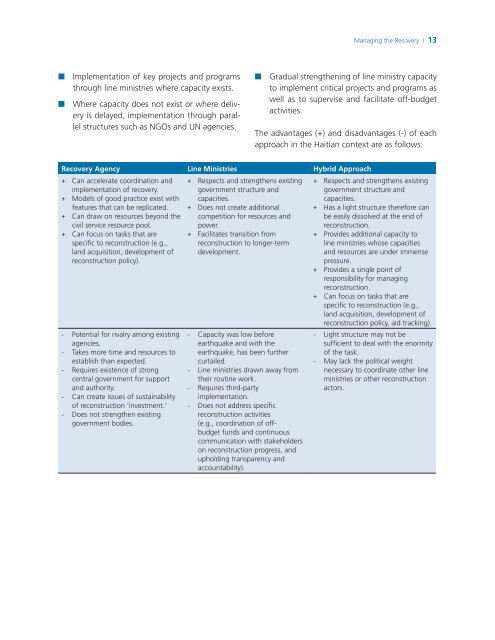Haiti Earthquake Reconstruction Knowledge Notes from ... - GFDRR
Haiti Earthquake Reconstruction Knowledge Notes from ... - GFDRR
Haiti Earthquake Reconstruction Knowledge Notes from ... - GFDRR
Create successful ePaper yourself
Turn your PDF publications into a flip-book with our unique Google optimized e-Paper software.
Managing the Recovery | 13<br />
■■<br />
■■<br />
Implementation of key projects and programs<br />
through line ministries where capacity exists.<br />
Where capacity does not exist or where delivery<br />
is delayed, implementation through parallel<br />
structures such as NGOs and UN agencies.<br />
■■ Gradual strengthening of line ministry capacity<br />
to implement critical projects and programs as<br />
well as to supervise and facilitate off-budget<br />
activities.<br />
The advantages (+) and disadvantages (-) of each<br />
approach in the <strong>Haiti</strong>an context are as follows:<br />
Recovery Agency Line Ministries Hybrid Approach<br />
+ Can accelerate coordination and + Respects and strengthens existing + Respects and strengthens existing<br />
+<br />
implementation of recovery.<br />
Models of good practice exist with<br />
government structure and<br />
capacities.<br />
government structure and<br />
capacities.<br />
features that can be replicated. + Does not create additional<br />
+ Has a light structure therefore can<br />
+ Can draw on resources beyond the competition for resources and be easily dissolved at the end of<br />
+<br />
civil service resource pool.<br />
Can focus on tasks that are +<br />
power.<br />
Facilitates transition <strong>from</strong><br />
+<br />
reconstruction.<br />
Provides additional capacity to<br />
specific to reconstruction (e.g.,<br />
land acquisition, development of<br />
reconstruction policy).<br />
reconstruction to longer-term<br />
development.<br />
+<br />
line ministries whose capacities<br />
and resources are under immense<br />
pressure.<br />
Provides a single point of<br />
+<br />
responsibility for managing<br />
reconstruction.<br />
Can focus on tasks that are<br />
specific to reconstruction (e.g.,<br />
land acquisition, development of<br />
reconstruction policy, aid tracking).<br />
-<br />
-<br />
-<br />
-<br />
-<br />
Potential for rivalry among existing<br />
agencies.<br />
Takes more time and resources to<br />
establish than expected.<br />
Requires existence of strong<br />
central government for support<br />
and authority.<br />
Can create issues of sustainability<br />
of reconstruction ‘investment.’<br />
Does not strengthen existing<br />
government bodies.<br />
-<br />
-<br />
-<br />
-<br />
Capacity was low before<br />
earthquake and with the<br />
earthquake, has been further<br />
curtailed.<br />
Line ministries drawn away <strong>from</strong><br />
their routine work.<br />
Requires third-party<br />
implementation.<br />
Does not address specific<br />
reconstruction activities<br />
(e.g., coordination of offbudget<br />
funds and continuous<br />
communication with stakeholders<br />
on reconstruction progress, and<br />
upholding transparency and<br />
accountability).<br />
-<br />
-<br />
Light structure may not be<br />
sufficient to deal with the enormity<br />
of the task.<br />
May lack the political weight<br />
necessary to coordinate other line<br />
ministries or other reconstruction<br />
actors.

















